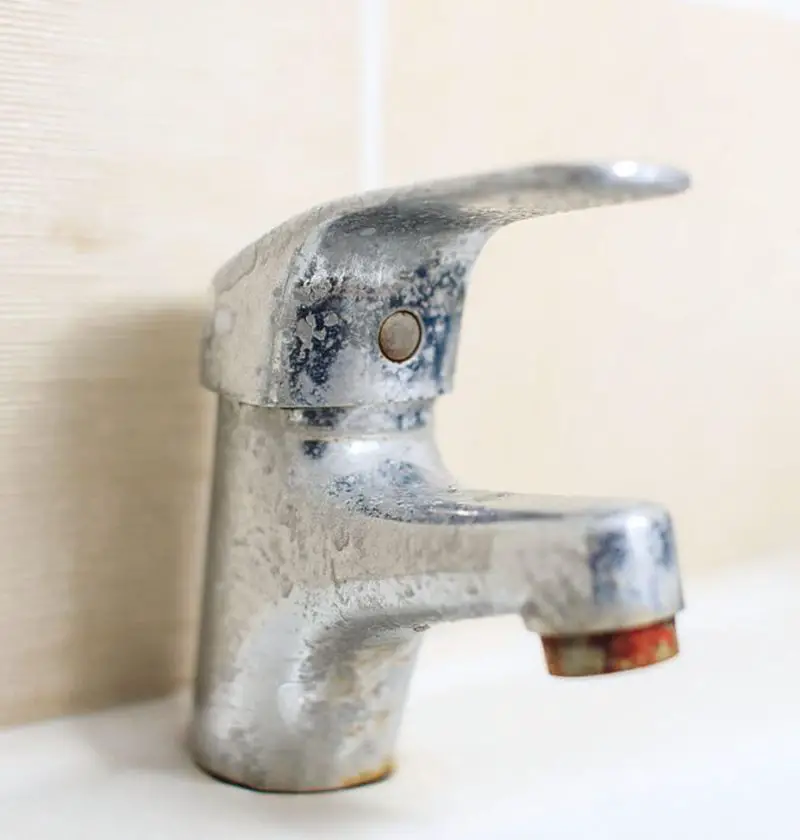Growing up, weekends at my nana’s house meant two things: warm biscuits from scratch, and learning all the little tricks she used to keep her home sparkling without spending a fortune. She didn’t believe in buying fancy cleaners—or wasting energy scrubbing until your arms were sore.
One trick I’ll never forget? Her foolproof, two-minute method for removing hard water stains. It seemed like magic the first time I watched her do it—and I still use it today, in my own home, every time those chalky little spots show up.
Whether your bathroom faucet is looking dull, your shower doors are streaky, or your glasses come out of the dishwasher with spots, this one simple trick could save you hours of scrubbing… and a whole lot of frustration.
Let’s get into it.
First, What Are Hard Water Stains, Anyway?
If your water leaves behind weird spots or filmy buildup, chances are you’ve got hard water. That just means your water is rich in minerals like calcium and magnesium. When the water dries or evaporates, those minerals stay behind—and boom, you’ve got yourself a hard water stain.
They love to show up on:
-
Faucets and fixtures
-
Glass shower doors
-
Dishware and drinking glasses
-
Tiles and sinks
Left alone, these deposits build up over time. And while they’re not dangerous, they definitely don’t make your space feel clean or cared for.
The Secret Ingredient? It’s Probably Already in Your Pantry
You might want to sit down for this because it’s almost too simple: white vinegar.
That’s it. No $12 “miracle” cleaner, no weird gel you saw on TikTok. Just good old-fashioned white vinegar. My nana always had a jug under the sink—and now, so do I.
Why vinegar? It’s mildly acidic, which makes it perfect for breaking down those mineral deposits without damaging most household surfaces.
Why It Works So Darn Well
Here’s the science-y part: the acid in vinegar reacts with the calcium and magnesium in the hard water deposits, breaking them down into little particles that can be wiped away with zero elbow grease.
No scrubbing. No special tools. The vinegar does all the heavy lifting for you. (Cue choir of angels.)
Step-by-Step: Nana’s 2-Minute Cleaning Hack
Alright, here’s exactly how I do it—just like she taught me.
What you need:
-
About ½ cup of plain white vinegar
-
A spray bottle (or you can just pour it carefully)
-
A microfiber cloth or paper towel
Instructions:
-
Pour your vinegar into a spray bottle. No need to dilute it—use full strength for best results.
-
Spray the stained area generously. Really let it soak. (For smaller items like a glass or faucet part, you can just soak them in a bowl of vinegar.)
-
Let it sit for 2 minutes. Go check your email. Sip your coffee.
Save This Recipe
-
Wipe clean. That’s it. No scrubbing. No cursing. Just wipe—and you’ll see those stains vanish like magic.
If the stains are extra stubborn (like if they’ve been sitting there for months), you can let the vinegar sit a little longer or do a second round.
A Quick Note About What Not to Do
Vinegar is amazing, but it’s not a cure-all for every surface.
Don’t use it on:
-
Marble or granite (it can etch the surface)
-
Natural stone tiles
-
Certain metals like brass or aluminum if uncoated
Always test a tiny, hidden spot first—especially if you’re cleaning something delicate or pricey.
What About All Those Other “Viral Hacks”?
Sure, there are tons of trendy ideas floating around online—some useful, some… not so much.
Lemon juice works, but it’s pricier and less concentrated than vinegar.
Baking soda? Good for scrubbing—but it takes more time and effort.
Commercial cleaners? Many are effective, but they’re also loaded with harsh chemicals and fumes.
At the end of the day, vinegar wins for me: it’s cheap, safe, effective, and doesn’t leave behind any weird residue or smell (after a quick rinse or wipe-down).
Want Fewer Stains to Deal With? Try These Prevention Tips
-
Wipe down wet surfaces right after use. A quick towel-off keeps minerals from settling.
-
Use a squeegee on your shower doors after every shower.
-
Install a water softener if your home has very hard water—it’s an investment, but it can save your appliances and your sanity in the long run.
-
Dry your dishes right away instead of letting them air-dry with hard water spots.
How Often Should You Do This?
It depends on how hard your water is, and how often the area gets used. Here’s a general rule of thumb:
-
Very hard water: Once a week
-
Moderate hard water: Every 2–3 weeks
-
Light use areas: Once a month
The beauty of this hack is that it’s quick and low-effort. You don’t have to block off a Saturday afternoon—you can literally do it while the pasta boils or during a commercial break.
Real-Life Results (A.K.A. Proof It Works)
I’ve had friends message me saying, “Okay, I finally tried your vinegar trick—and WOW.” One even sent me a photo of her once-cloudy shower door, now gleaming like new.
If you’ve been using fancy sprays or spending too long scrubbing with no results, this little hack might just change your whole cleaning game.
Final Thoughts From My Nana’s Grandkid
Some of the best advice I’ve ever gotten came from women who cleaned their homes with vinegar, newspaper, and a lot of love. This hard water hack isn’t trendy or glamorous—but you know what? It works.
And in a world full of gimmicks, sometimes that’s all you need.
Have you tried this hack—or have your own handed-down cleaning secret? I’d love to hear it! Share it in the comments or send me a note. I believe there’s a little magic in every home remedy, especially the ones passed down with love.

